The Premier League returns this weekend following the international break, and the season is at a crucial stage, with the finish line in sight. Manchester City have a 14-point lead over second-placed Manchester United, albeit having played a game more, and so are champions-elect as long as they can be consistent in their remaining eight matches. This Saturday sees them travelling to the King Power Stadium to play against Leicester City, who are third in the table, just one point behind United, and gunning for a spot in the UEFA Champions League next season.
Brendan Rodgers’ team are clearly having a good season; despite missing out on a Champions League spot last season by the smallest of margins, the Foxes have been able to regroup and show the form they displayed for much of last season, but with the added consistency that sees them in a good position for the last stretch of this campaign. They have made it to the semi-finals of the FA Cup as well, but the focus for this week will be the league.
Their previous meeting this season had been one of City’s worst defeats under Pep Guardiola, as the Foxes ran rampant at the Etihad to win 5-2. However, this match was a long time ago, and City, in particular, have improved by leaps and bounds since then, so it is unlikely that we will see a repeat of any sort in this game. It will still be a fascinating encounter, and in this tactical preview, we will have an analysis of both sides’ possible tactics, suggesting how they could maximize their strengths to come out on top in this heavyweight clash.
Predicted lineups
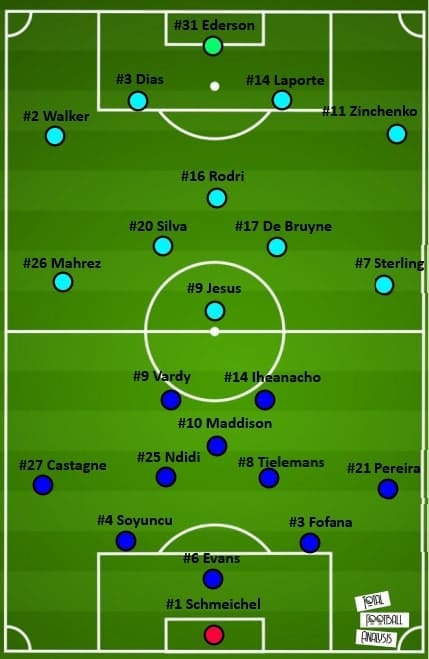
Leicester City: Kasper Schmeichel; Ricardo Pereira, Timothy Castagne, Wesley Fofana, Jonny Evans, Çağlar Söyüncü; Youri Tielemans, Wilfred Ndidi, James Maddison; Jamie Vardy, Kelechi Iheanacho
Leicester City still have some key players such as James Justin and Harvey Barnes sidelined through injury, but have welcomed back the likes of Ricardo Pereira, Çağlar Söyüncü and Timothy Castagne in recent weeks. At the time of writing, James Maddison’s status was still up in the air, but we assume that he will be fit enough to start.
Manchester City: Ederson; Kyle Walker, Oleksandr Zinchenko, Aymeric Laporte, Rúben Dias; Rodrigo Hernández, Kevin De Bruyne, Bernardo Silva; Raheem Sterling, Riyad Mahrez, Gabriel Jesus
Predicting a City lineup correctly has always been a difficult task, and more so this season where Guardiola has been rotating more than usual to keep his players fresh during a very packed and relentless schedule. We have prioritized those players in our selection who got enough rest during the international break, such as Aymeric Laporte and Gabriel Jesus, among others. City have the first leg of their Champions League quarter-final against Borussia Dortmund on Wednesday, so we can definitely expect some players, such as İlkay Gündoğan, to be rested. Moreover, Riyad Mahrez and Bernardo Silva have been in good forms lately so they can be expected to start, while Raheem Sterling may get another chance to get back into City’s first-choice lineup, having recently fallen out of favour due to his lack of intensity in training.
Leicester’s offensive threat
The Foxes have registered 53 goals in the league so far this season, which is the third-highest and shows their attacking potency. Despite being the underdogs in this match, Brendan Rodgers will definitely be working on some plans to allow Leicester to attack the City goal as frequently as possible. Leicester have been using some effective attacking tactics in recent weeks which we can expect to see in this game as well.
With Ben Chilwell joining Chelsea in the summer, Leicester did not recruit a left-footed left-back. Instead, Rodgers has used Justin and Castagne, both of whom are right-footed, on the left, and both players have impressed so far this season. These players have offered diagonality when using their stronger foot to pass, which has allowed the Irishman to develop attacking structures to take advantage of this.
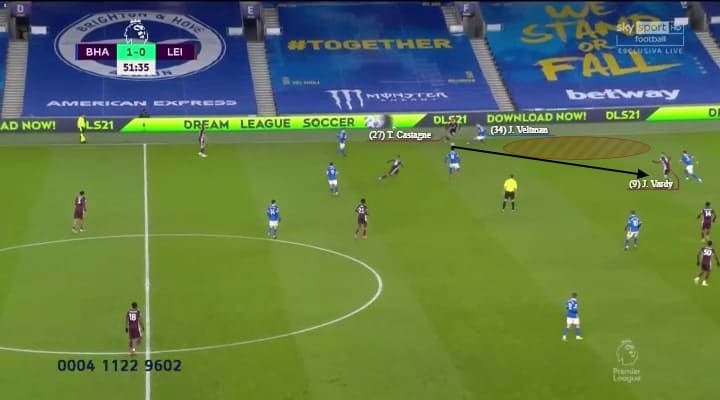
Leicester are good at utilizing the entire width of the pitch, pulling the wide defenders out of position and attacking the spaces behind them. This has been a consistent theme of their attacking play, whether they have played with a back four or a back three with wing-backs, with only some details being different between these two systems.
For example, the Foxes played with a back three against Brighton, where the left wing-back, Castagne, was tasked with providing the width. By doing so, the opposition right-back, Joël Veltman was forced out of position to defend him, leaving space behind (highlighted in red). In these situations, the Belgian international had various options, including finding Vardy diagonally, or having a runner attacking that space beyond Veltman.
Usually, the wide player did not stay too high, in order to distance himself from the opposition, increasing the time and space needed for the opposition full-back to access him. This would ensure that enough of an angle was created for the pass into the final third.
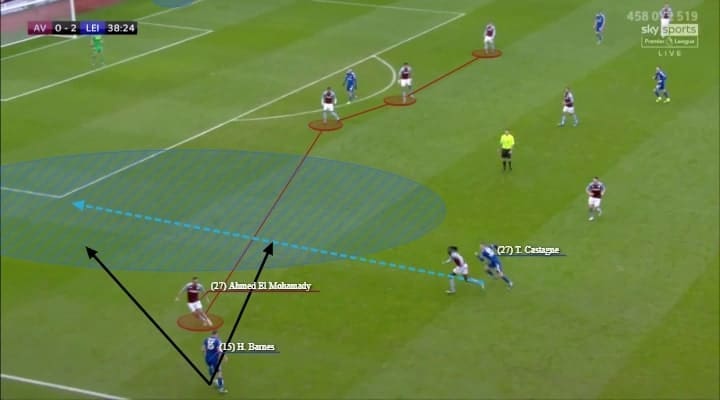
Even when Leicester have played with a back four, the same concepts have been applied to open up spaces for these passes. In this image, we see Harvey Barnes. the left winger, dragging the Villa right-back (Ahmed Elmohamady) to the wide zone, increasing the horizontal gap between the Villa defenders (shaded in blue).
Since Barnes was almost at the touchline, Elmohamady would be late to close his passing angle, while the left-back, Castagne attacked the space. Again, with a right-footed player on the left, these diagonal passes can be played into the highlighted area, with Barnes having the option to play the pass in front of or behind the defensive line, depending on Castagne’s movement.
If these passes were able to release the runner, Leicester would be able to create dangerous situations through a pass or cross into the box.
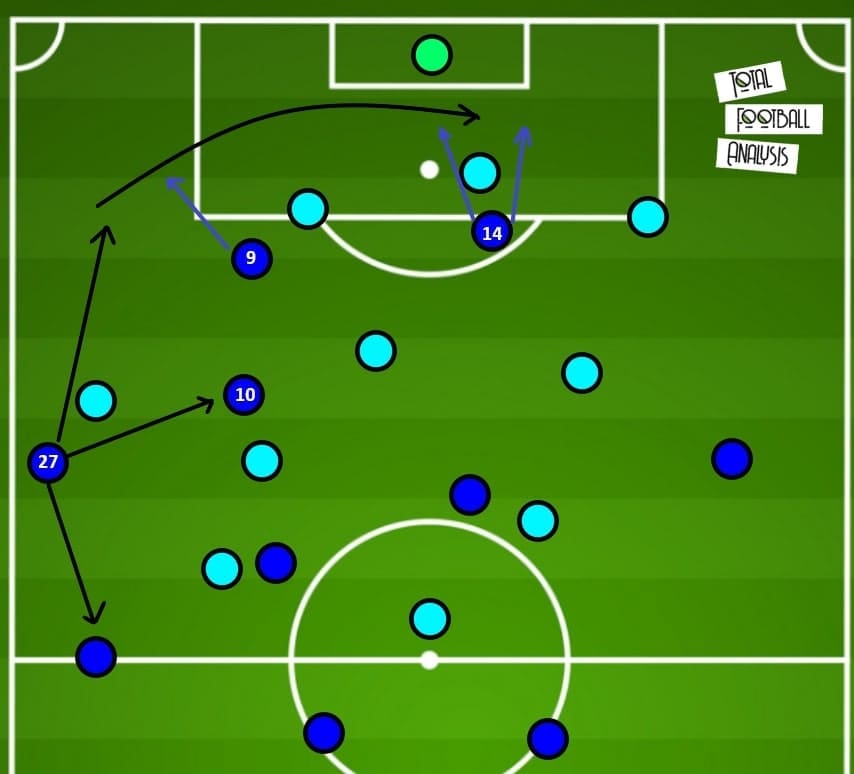
So, how can Leicester implement similar ideas against City?
Assuming that Maddison will return to the lineup, his addition will increase the dynamics of the team. The centre-backs can carry the ball forward and find the left wing-back on the touchline, where we expect the City right-back will come out to engage him, resulting in the creation of space behind him in a similar manner to the instances we have shown. Vardy can make those runs into the vacated space, and City’s right-sided centre-back will have to cover the right-back well in these situations, or else the Foxes will be able to create dangerous situations through this pattern of play.
The additional element here can come through Maddison’s presence. The former Norwich City playmaker understands space well, with excellent movement to take advantage of it in the final third, and he is also good at receiving the ball in tight areas. Therefore, when the wide player has the ball, Maddison could offer a short lateral passing option, exploiting the fact that the centre-back will probably be occupied by Vardy. Castagne could therefore have at least have three passing options in such situations, including the return pass to the centre-back as well. If City shifted to the ball-side early to close these spaces, Leicester can circulate the ball to the other side through the defenders.
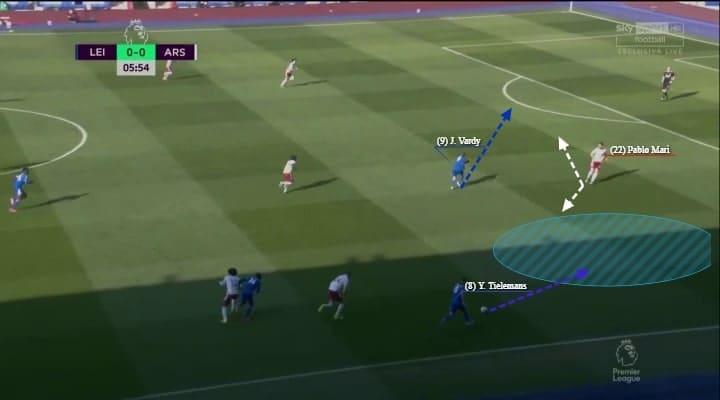
Another area that City must pay attention to is Leicester’s counter-attacking threat. With players such as Vardy and Maddison in the team, who are excellent in offensive transitions, Leicester have developed some good patterns to create opportunities in such situations.
We have highlighted Vardy’s movement in this phase as his runs have been crucial to creating favourable scenarios during counter-attacks. We can take Youri Tielemans’ goal against Arsenal as an example – here, Vardy’s decision to run away from the ball was the key. The run created space for him to shoot if Pablo Marí pressed Tielemans. However, the Brazilian defender decided to track Vardy, so Tielemans could enter the highlighted space, carry the ball into the box and scored himself. Vardy’s run was also a diagonal run rather than vertical to stay onside, so even if Marí stepped up, Vardy would be able to receive the ball while being onside.
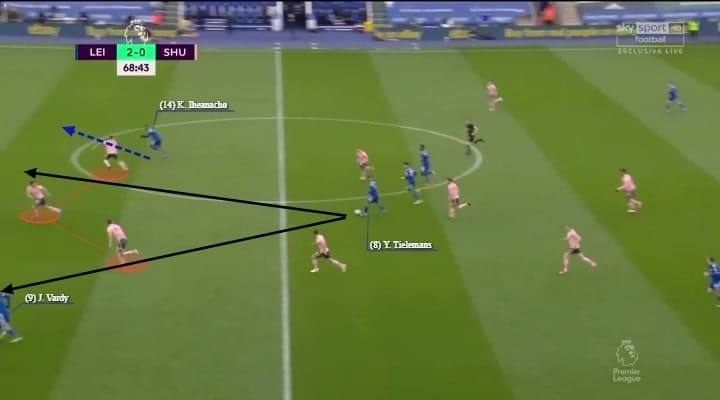
Another concept utilised by Leicester is similar to “filling the lanes” in basketball, in which Leicester’s attackers try to stretch the defensive line to create enough space for the release pass. The attacking players begin their runs from the centre, running behind the defence but diagonally, to stay onside and stretch the defensive line. Their goal against Sheffield United is a good example of this.
Here, initially when Tielemans is on the ball, Iheanacho and Vardy were already making runs outside. These runs stretched the back three horizontally, increasing the channels available for the Belgian international to pass.
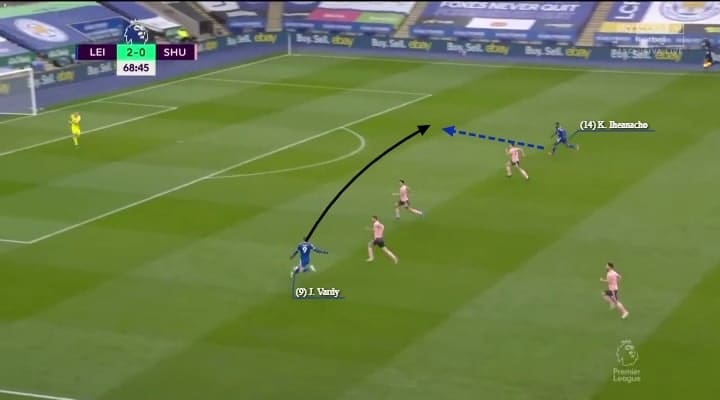
Tielemans found Vardy on the left, outside the defenders. Iheanacho’s initial diagonal run meant that he was now on the blindside of the defenders on the far side, and Vardy had a simple pass to feed the ball into Iheanacho’s path, and put the Nigerian international in a 1v1 with the goalkeeper. We can expect these kind of situations in this game, where Leicester try to attack City’s high defensive line in transitions. It is crucial for City to therefore not give away possession in dangerous areas if they want to avoid this.
Can City demolish the block?
City must defend well and try to keep a clean sheet, but they would want the three points as well, and so will look to take the game to the Foxes as well. We can take some clues from City’s win over Everton in the FA Cup sixth round, since Carlo Ancelotti’s men set up in a 5-3-2 shape, similar to what Leicester are expected to use in this match.
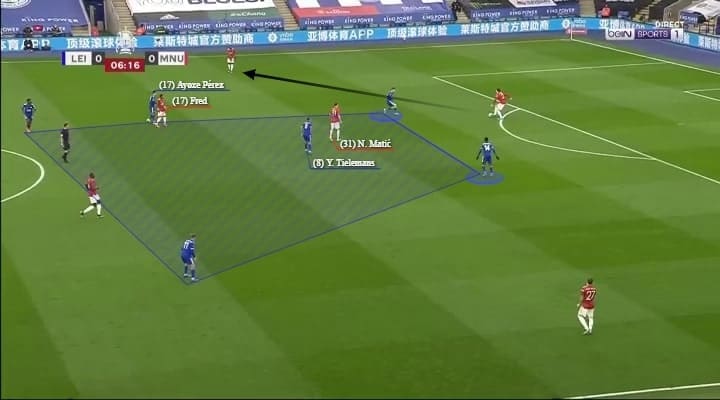
The first image shows Leicester’s defensive style of play during the opposition’s build-up phase. The key aim of their block is to defend central areas, removing midfielders as passing options to force the ball outside, no matter what the opposition’s shape.
In their FA Cup sixth round game against Manchester United, Leicester kept a compact block in the centre, paying specific attention to Fred and Nemanja Matić. United’s midfield duo were unable to receive the ball from their centre-backs due to the Foxes’ strikers positioning them in their cover shadow, and the midfielders stepping up to mark them.
The image shows how six Foxes players shut down the inside of the pitch with their midfielders stepping up on the United midfielders. Their 6v5 advantage in the centre would open the wide spaces up for United to pass into those areas, where Leicester would then shift the block to press them and recover possession.
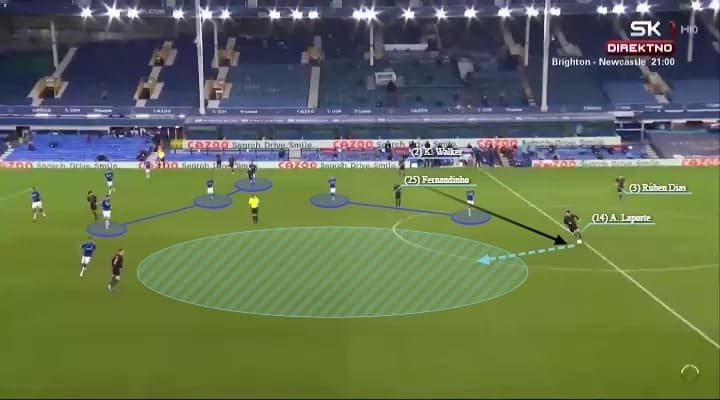
City should not be caught out by this, as they had a similar experience recently against Everton, and the way they move their players around will be the key to open spaces up centrally. In the second half of that game, City at times tried to attack down the right, but then quickly shifted the ball back to the left after the opposition shifted over. The ball is always quicker than the players, and so by utilising quick passing sequences to find the free man, City were able advance the ball into space centrally.
In that game, they overloaded Everton’s two-man first line by creating a back three. Interestingly, the back three was not an ordinary one with the three centre-backs occupying both half-spaces and the central space. Instead, Walker stayed very wide on the touchline to receive passes, forcing Everton’s block to shift towards his side. Meanwhile, Fernandinho did not drop between the defenders, his job was to provide another layer, staying central to fix the Everton strikers’ positions.
This image was the scenario before City’s opener. We can see Laporte bringing the ball into the free left half-space, which was created through the elements mentioned above. The attack initially developed on the right, so the opposition was on the other side. When the ball was moved back across quickly, Everton’s right-sided midfielder was late to recover, and that opened up the highlighted space. Also, Fernandinho’s positioning kept the striker inside. as the Brazilian intentionally stayed away from the ball, buying time for Laporte to advance. A good build-up will be needed for City to break the Leicester block, and they may need to use their positional awareness to do something similar.
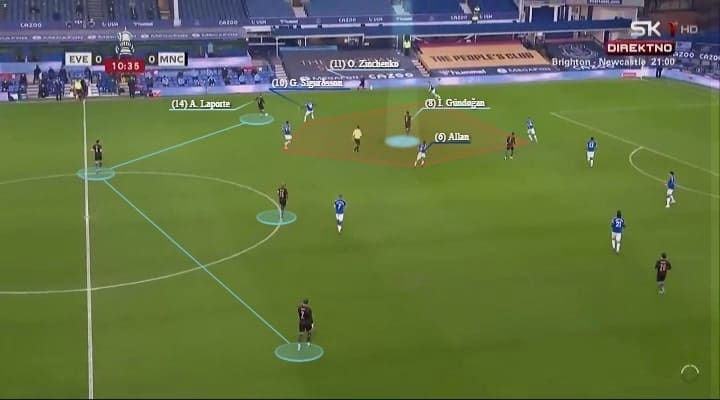
Another situation here, where again City’s 3-1 shape was spread very wide. But the 3v2 numerical overload at the first line undoubtedly allowed Laporte to bring the ball forward, where it would be difficult for the striker to follow him. The Everton wide midfielder had to step up to Laporte, which meant that Gündoğan was now free in the highlighted red zone as Gylfi Sigurðsson moved towards Laporte.
This was a positional dilemma for the defensive midfielder (Allan). If he stuck tight to Gündoğan, the central space in front of the penalty area would be left unprotected. This is exactly the kind of situation City would want to create against Ndidi on Saturday, by using the wide centre-backs to advance the ball.
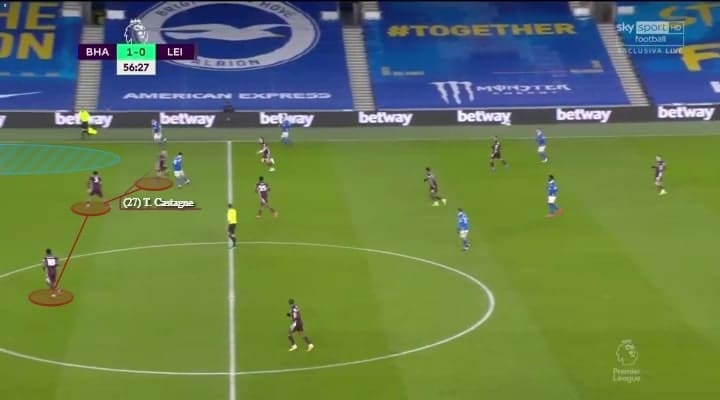
The last few examples show some weaknesses of Leicester’s which City should look to exploit. They are related to Leicester’s spacing behind the midfield, where, in general, the Leicester defenders are not good at defending space in front of them. Their timing of when to step up and when to sit back has been inaccurate on occasion, causing them to give up dangerous chances this season.
The centre-backs and wing-backs often misjudged the timing of when to step up and were therefore late on the ball. If the City player between the lines is quick enough, he should be able to receive and release runners behind the defenders due to this.
In the above image, Castagne mistimes his move towards the Brighton player and is consequently very late to arrive, failing to close the angle for the pass. One simple pass was all it took for Brighton to get in behind the Foxes’ defence from this situation.
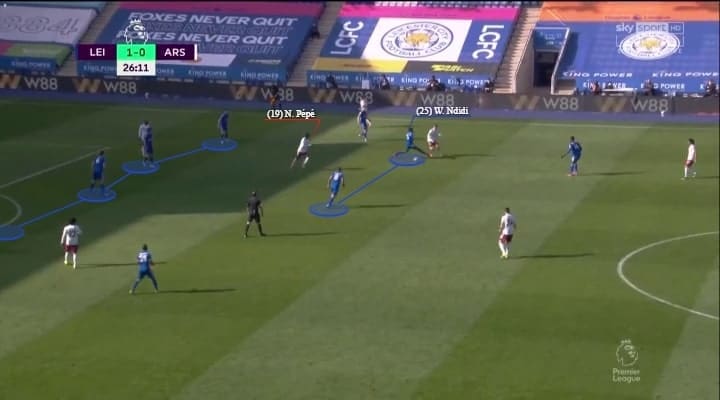
Another situation that City can try to exploit is when Ndidi steps up to challenge. The Nigerian player is good at defending space, but he also suffers from being a little too eager to step up at times. This means that he commits himself too early, resulting in huge spaces between the lines, which City can exploit on Saturday.
In this image, Ndidi tries to steal the ball but he was too late, and therefore Nicolas Pépé now has space and time on the ball, because the centre-backs stayed deeper since they are not good at defending spaces in front. Manchester City will definitely try to take advantage of these situations, should they arise.
Final remarks
This match is expected to be a tight battle at the King Power Stadium, and as we have pointed out in this analysis, both teams have enough about them to win this game.





Comments